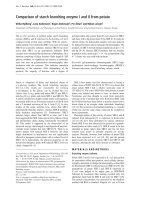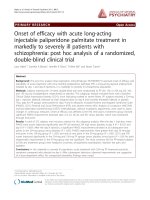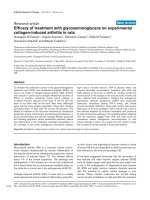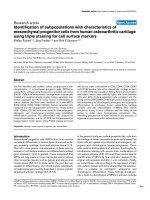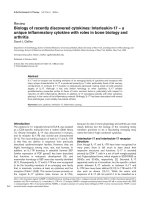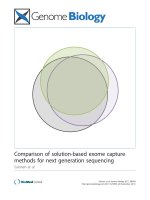Báo cáo y học: " Comparison of thromboelastometry with procalcitonin, interleukin 6, and C-reactive protein as diagnostic tests for severe sepsis in critically ill adults" ppsx
Bạn đang xem bản rút gọn của tài liệu. Xem và tải ngay bản đầy đủ của tài liệu tại đây (432.79 KB, 7 trang )
RESEARC H Open Access
Comparison of thromboelastometry with
procalcitonin, interleukin 6, and C-reactive protein
as diagnostic tests for severe sepsis in critically ill
adults
Michael Adamzik
1
, Martin Eggmann
1
, Ulrich H Frey
1
, Klaus Görlinger
1
, Martina Bröcker-Preuß
2
, Günter Marggraf
3
,
Fuat Saner
4
, Holger Eggebrecht
5
, Jürgen Peters
1
, Matthias Hartmann
1*
Abstract
Introduction: Established biomarkers for the diagnosis of sepsis are procalcitonin, interleukin 6, and C-reactive
protein. Although sepsis evokes changes of coagulation and fibrinolysis, it is unknown whether
thromboelastometry can detect these alterations. We investigated whether thromboelastometry variables are
suitable as biomarkers for severe sepsis in critically ill adults.
Methods: In the observational cohort study, blood samples were obtained from patients on the day of diagnosis
of severe sepsis (n = 56) and from postoperative patients (n = 52), and clotting time, clot formation time,
maximum clot firmness, alpha angle, and lysis index were measured with thromboelastometry. In addition,
procalcitonin, interleukin 6, and C-reactive protein levels were determined. For comparison of biomarkers, receiver
operating characteristic (ROC) curves were used, and the optimal cut-offs and odds ratios were calculated.
Results: In comparison with postoperative controls, patients with sepsis showed an increase in lysis index (97% ±
0.3 versus 92 ± 0.5; P < 0.001; mean and SEM) and procalcitonin (2.5 ng/ml ± 0.5 versus 30.6 ± 8.7; P < 0.001). Clot-
formation time, alpha angle, maximum clot firmness, as well as interleukin 6 and C-reactive protein concentrations
were not different between groups; clotting time was slightly prolonged. ROC analysis demonstrated an area under
the curve (AUC) of 0.901 (CI 0.838 - 0.964) for the lysis index, and 0.756 (CI 0.666 - 0.846) for procalcitonin. The
calculated cut-off for the lysis index was > 96.5%, resulting in a sensitivity of 84.2%, and a specificity of 94.2%, with
an odds ratio of 85.3 (CI 21.7 - 334.5).
Conclusions: The thromboelastometry lysis index proved to be a more reliable biomarker of severe sepsis in
critically ill adults than were procalcitonin, interleukin 6, and C-reactive protein. The results also demonstrate that
early involvement of the hemostatic system is a common event in severe sepsis.
Introduction
Sepsis is a common cause of death in critically ill patients,
and early diagnosis is mandatory to improve the prognosis.
Commonly used biomarkers like procalcitonin, C-reactive
protein, and interleukin 6 are produced by the host in
response to infections. However, the concentrations of
these biomarkers can increase in patients with trauma or
surgery, even without infection, and, therefore, their diag-
nostic value in critically ill patients is far from perfect [1].
In patients with sepsis, activation of hemostasis is of
marked pathophysiologic relevance, as it is asso ciated
with increased mortality [2]. As the mechanism, fibrin
deposition in the vasculatu re, leading to ischemia and
multiorgan failure, is assumed [3]. Only sparse informa-
tion, however, is available on the use of thro mboelasto-
metry in sepsis. This method measures the mechanical
properties of a forming clot in whole-blood samples in a
time-dependent fashion and is a n increasingly accepted
* Correspondence:
1
Klinik für Anästhesiologie und Intensivmedizin, Universitätsklinikum Essen
und Universität Duisburg-Essen, Hufelandstr. 55, 45130 Essen, Germany
Full list of author information is available at the end of the article
Adamzik et al. Critical Care 2010, 14:R178
/>© 2010 Hartmann et al.; licensee BioMed Central Ltd. This is an open access article distributed under the terms of the Creative
Commons Attribution License ( enses/by/2.0), which permits unrestricted use, distribution, and
reproduction in any medium, provided the original work is properly cite d.
point-of-care method for monitoring and therapy of
hemostatic disturbances [4]. In a recent study, we
demonstrated that endotoxinemia can be detected with
thromboelastometry under in vitro conditions [5].
Thromboelastometric variables remained within refer-
ence ranges during the course of critically illness in 30
patients with sepsis [6]. In another study, however, early
changes in thromboelastometry values were demon-
strated in endotoxin-treated pigs [7].
The aim of the present study was to investigate the value
of thromboelastometry variables as potential biomarkers of
sepsis in critically ill adults and to compare these hemosta-
sis-related biomarkers with the established markers pro-
calcitonin, interleukin 6, and C-reactive protein.
Materials and methods
Patients
The study was reviewed and approved by the Ethics
Committee of the University Hospital Essen. In detail,
informed written consent was given by both postopera-
tive patients and probands. Informed consent of patients
with sepsis was waived by the ethics committee, but writ-
ten informed consent for the use of data was acquired by
the surviving patients after recovery from the disease.
Over a period of 2 years, 56 patients admitted to an ICU
of the Unive rsity Hospital of Essen were considered eligi-
ble for the study if they fulfilled t he criteria for severe
sepsis (sepsis group) [8]. As the second group, patients
admitted to the ICU af ter surgery but without the criter-
ion of sepsis were chosen (postoperative group). Groups
were not matched. A detailed characterization of patients
and controls is given in Table 1. As a third group, healthy
probands were chosen (probands gro up). In all groups,
whole-blood samples were subjected to thromboelasto-
metry (ROTEM 05; Pentapharm, Germany). Samples
from septic and postoperative patients were drawn within
24 hours of diagnosis and surgery, respectively. Further-
more, procalcitonin, interleukin 6, and C-reactive protein
concentrations as well as SAPS II and SOFA scores wer e
determined in these groups at the same time [9,10].
Thromboelastometry
Whole-blood coagulation properties of citrated blood
samples were determined by using thromboelastometry.
To exclude potential effects of heparin on coagulation,
20 μl heparinase was added to the samples according to
the manufacturer’s recommendations (Pentapharm,
München, Germany). Thereafter, samples were sub-
jected to thromboelastometry (RO TEM 05; Penta-
pharm), and coagulation was initiated by addition of
CaCl
2
(20 μl, 0.2 M CaCl
2
, NaTEM test). Clotting time
(CT), clot-formation time (CFT), maximum clot firm-
ness (MCF), alpha angle, and the 60-minute lysis index
were determined.
Assays for procalcitonin, interleukin 6, and C-reactive
protein concentrations
For the determination of procalcitonin concentration, the
Liaison Brahms PCT assay (Diasorin S.p.A., Sallugia, Italy)
was used. C-reactive pr otein was mea sure d by using the
CRP wide-range assay of the Avidia 1650 chemistry system
(Bayer Healthcare LLC, Leverkusen, Germany). Interleukin
6 was determined by using an Immulite 2000 systems ana-
lyzer and reagents (Siemens Healthcar e Diagnostics Pro-
ducts Ltd., Duisburg, Germany).
Statistical analysis
Values for the thromboelastometry variables and concen-
trations of procalcitonin, interleukin 6, and C-reactive pro-
tein in patients with and without severe sepsis are given as
mean and standard error of the mean (SEM), as well as
median and 25
th
and 75
th
percentiles. The Shapiro-Wilk
test excluded a normal distribution for several values.
Therefore, the Mann-Whitney test was used for statistical
evaluation. For the comparison of biomarkers, receiver
operating characteristic (ROC) curves were used, and
Table 1 Characteristics of patients with sepsis and
postoperative patients
Patient characteristics Sepsis Postoperative patients
Number of patients 56 52
Age, years 54 ± 17 55 ± 17
Male/female 31/25 28/24
Weight, kg 79.9 ± 23.5 74.9 ± 26.5
Primary diagnosis
Gastrointestinal cancer 7 18
Gastrointestinal disease 16 8
Cancer, other 5 12
Urogenital cancer 3 9
11 0
Lung disease 9 0
Urogenital disease 3 1
Other diseases 1 4
Lung cancer 1 0
Disease severity
CVVHD 33 0
Mechanical ventilation, % 100 100
SAPS II score 51.4 ± 14.9 20.8 ± 9.0
SOFA score 12.5 ± 3.9 3.85 ± 2.6
Infection type
Gram-positive isolates, % 28 0
Gram-negative isolates, % 49 0
Viral isolates, % 0 0
Fungal isolates, % 11 0
Included are biometric data, primary diagnosis, disease severity, and infection
type as diagnosed within 24 hours after admission. Data are given as mean
and standard error of the mean. CVVHD, continuous venovenous
hemodiafiltration.
Adamzik et al. Critical Care 2010, 14:R178
/>Page 2 of 7
these results are given as area under the curve (AUC), 95%
confidence interval (CI), and asymptotic significance
(P value). Furthermore, the optimal cut-off value for each
biomarker was calculated, and the corresponding sensitiv-
ities and specifities are presented. Optimal sensitivity and
specificity were defined as those yielding the minimal
value for (1 - sensitivity)
2
+ (1 - specificity)
2
, as described
[11]. With the calculated opti mal cut-off values, the odds
ratios were calculated along with the respective 95% CIs,
as well as the significance values, by using the c
2
test.
SPSS Version 16 (SPSS Inc., Chicago, IL, USA) was used
for all statistical procedures, and an a priori alpha error
P of < 0.05 was considered statistically significant.
Results
Thromboelastometry variables in probands and
postoperative patients
In comparison with probands, postoperative patients
showed an increased hemostasis potential. Thromboelas-
tometry variables were characterized by a shorter clot-
ting time and clot-formation time, as well as increased
alpha angle and maximum clot firmness. Remarkably,
the lysis index was not different in probands and post-
operative patients (Table 2).
Thromboelastometry variables in critically ill patients with
and without severe sepsis
In comparison with postoperative patients, sepsis
patients showed an increased lysis index (97.0% ± 0.3
versus 92.0 ± 0.5; P < 0.001) Clot-formation time, alpha
angle, and maximum clot firmness were not significantly
different between groups (Table 2), but the clotting time
was slightly prolonged.
Conventional biomarkers in critically ill patients with and
without severe sepsis
Procalcitonin, interleukin 6, and C-reac tive protein con-
centrations were tested for differences between patients
with and without sepsis. Procalcitonin concentration
averaged 2.5 ng/ml ± 0.5 in postoperative patients but
30.6 ng/ml ± 8.7 in patients with severe sepsis (P <
0.001). Neither interleuk in 6 nor C-reactive protein con-
centrations were significantly different between patients
with and without sepsis (Table 3). In both posto perative
and sepsis patients, mean values for procalcitonin, inter-
leukin 6, and C-reactive protein exceeded the reference
interval by far (Table 3).
Comparison of thromboelastometry variables and
conventional biomarkers for the diagnosis of severe
sepsis in critical ill adults
As shown above, thromboelastometry lysis index and
procalcitonin concentration were different in postopera-
tive and sepsis patients. To further investigate the diag-
nostic value of these variables as potential biomarkers of
severe sepsis in critical illness, a ROC curve analysis was
performed. Furthermore, the 95% confidence intervals
(CI), as well as the asymptotic significance niveaus were
determined. The best accuracy was yielded by the lysis
index, with an AUC of 0.901 (CI 0.838 - 0.964; P <
0.001), followed by procalcitonin concentration (AUC
0.75; CI 0.666 - 0.846; P < 0.001). The ROC curves for
these variables are shown in Figure 1. Comparison of
the lysis index in probands and patients with sepsis,
respecti vely, demonstrated that the variable was capable
of detecting differences between these groups with high
accuracy, too (AUC 0.890; CI 0.845 - 0.977; P < 0.001).
Optimal cut-off values for lysis index and procalcitonin
concentration for the diagnosis of sepsis in critically ill
adults
Optimal cut-off values were determined as described in
the Methods section. For the lysis index, the optimum
cut-off was > 96.5%, resulting in a sensitivity of 84.2%
and a specificity of 94.2%. Applying this cut-off for the
comparison of probands and sepsis patients, respectively,
Table 2 Thromboelastometry values in patients with sepsis, postoperative patients, and probands
Thromboelastometry Sepsis
Mean [SEM]
Median [quartiles]
Postoperative patients
Mean [SEM]
Median [quartiles]
Probands
Mean [SEM]
Median [quartiles]
Mann-Whitney test
Sepsis vs. postop, Sepsis vs. probands
Postop vs. probands
Lysis index
%
97.0 ± 0.3
98.0[97.3-98.0]
92.0 ± 0.5
92.0 [90.0-95.0]
92.6 ± 0.7
93.0 [91.3-95.0]
< 0.001; < 0.001; 0.53
Clotting time
Seconds
546 ± 30
513 [406-639]
434 ± 16
453 [386-485]
765 ± 33
774 [668-865]
0.012; < 0.001; < 0.001
Alpha-angle
Degree
55.4 ± 1.5
56.0[ 48.0-65.0]
59.3 ± 1.5
62.0 [56.0-67.0]
48.4 ± 1.8
46.5 [43.2-54.0]
0.085, 0.003; < 0.001
Clot-formation time
Seconds
229 ± 19
187 [136-271]
193 ± 17
166 [122-196]
259 ± 17
262 [206-303]
0.095; 0.01; < 0.001
Max. clot firmness
mm
55.4 ± 1.5
54.5 [49.3-65.0]
55.8 ± 1.3
57.0 [50.0-62.0]
51.8 ± 1.0
52.0 [47.5-54.8]
0.858; 0.10; 0.032
Values are given as mean and standard error of the mean as well as median and 25
th
and 75
th
percentiles (quartiles). The Mann-Whitney test was used for
statistical evaluation.
Adamzik et al. Critical Care 2010, 14:R178
/>Page 3 of 7
resulted in a sensitivity of 83.9% and a specificity of
> 99%. The optimum cut-off for procalcitonin concentra-
tion was > 2.58 ng/ml, resulting in a sensitivity of 70.2%
and a specificity of 75.0%.
Odds ratios for the biomarkers for the diagnosis of sepsis
in critically ill patients
When applying these calculated optimum cut-off values
for the biomarkers, the resulting odds ratios for the detec-
tion of severe sepsis in critically ill patients were 85.3 (CI
21.7 - 334.5; P < 0.001) for the lysis index and 6.3 (CI 2.7 -
14.4; P < 0.001) for procalcitonin concentration.
Discussion
Our results demonstrate that the thromboelastometry
lysis index can discriminate intensive care patients with
severe sepsis from postoperative patients and probands.
Furthermore, comparison of thromboelastometry
findings with the conventional biomarkers procalcitonin,
interleukin 6, and C-reactive protein demonstrates a
superior accuracy of the thromboelastometry lysis index
in identifying patients with severe sepsis in critically ill
patients. Finally, the data indicate that the fibrinolytic
system is inhibited in nearly all patients with severe
sepsis.
Thromboela stometry is a point-of-care method cap-
able of determining the kinetics of clot formation and
clot lysis in whole-blood samples, thereby assessing the
viscoelastic properties of the clot [12]. The clotting vari-
ables obtained by thromboelastometry include the clot-
ting time, representing the time to onset of coag ulation,
the clot-formation time and alpha angle, both of which
describe the kinetics of clot formation, and the maxi-
mum clot firmness, describing the mechanical properties
of the clot, which d epends on both platelet count and
fibrin polymerization. For the determination of the lysis
index, the clot firmness prevailing 60 minutes after max-
imum clot firmness is reached, is divided by the maxi-
mum clot firmness. Thromboelastometry is widely
accepted in cardiac and liver transplantation surgery
[13,14], but studies on its use in sepsis are sparse.
Although recent data obtained in experimental sepsis
and small patient cohorts suggest that sepsis-induced
alterations in hemostasis might be detected with throm-
boelastometry, it is unknown whether thromboelastome-
try variables might serve as biomarkers for the diagnosis
of severe sepsis [5-7,15].
In Figure 2, the results obtained by both the throm-
boelastometry lysis index and conventional biomarkers
(a) as well as the thromboelastometry clotting variables
(b) are summarized. The figure demonstrates that the
lysis index is not different in probands and postoperative
patients but is significantly higher in patients with
severe sepsis. Similarly, procalcitonin slightly increases
in postoperative patients and shows a further marked
increase in patients with severe sepsis. In contrast, inter-
leukin 6 and C-reactive protein are markedly higher in
postoperative patients, but no further increase is found
in patients with severe sepsis. Thus, thromboelastometry
lysis index and procalcitonin, but not interleukin 6 and
Table 3 Conventional biomarkers of sepsis in patients with sepsis and postoperative patients
Biomarker Sepsis
Mean [SEM]
Median [quartiles]
Postoperative patients
Mean [SEM]
Median [quartiles]
Reference values Mann-Whitney test
Sepsis vs. postop
P value
Procalcitonin
ng/ml
30.6 ± 8.7
5.5 [1.5-24.3]
2.5 ± 0.5
1.4 [0.4-3.3]
< 0.5 (probands) < 0.001
Interleukin 6
pg/ml
1,054 ± 426
114 [36-592]
313 ± 40
188 [120-422]
0-3.4 0.108
C-reactive protein
mg/dl
14.7 ± 1.3
13.6 [6.1-21.8]
12.5 ± 0.7
12.1 [8.9-16.2]
0-0.5 0.563
Reference values of the biomarker assays are given. Values are given as mean and standard error of the mean as well as median and 25
th
and 75
th
percentiles
(quartiles). The Mann-Whitney test was used for statistical evaluation.
Figure 1 Receiver operating characteristic curves comparing
thromboelastometry lysis index and procalcitonin
concentration for the diagnosis of severe sepsis in critically ill
patients.
Adamzik et al. Critical Care 2010, 14:R178
/>Page 4 of 7
C-reactive protein, are capable of detecting patients with
severe sepsis in critically ill adults. Concerning the
thromboelastometry clotting variables clotting time,
alpha angle, and clot-formation time, the present study
demo nstrates an increase d hemostasis potential in post-
operative patients (Figure 2b); maximum clot firmness
was not different in these groups. The differences
observed between postoperative patients and patients
with severe sepsis were small, not significant in most
cases, and thus do not allow detection of the patients
with severe sepsis.
It is a main result of the present study that the throm-
boelast ometry lysis index was increased in patients with
severe sepsis in comparison with probands and post-
operative patients, suggesting that the function of the
fibrinolytic system is markedly inhibited. Whereas clot
firmness decreased by 8% after 1 hour in patients with-
out sepsis and in probands, clot f irmness decreased by
only 3% in patients with severe sepsis. The fact that the
thromboelastometry lysis index was the most reliable
biomarker tested for the diagnosis of severe sepsis in
critically ill patients in our study demonstr ates that
thromboelastometry is capa ble of detecting changes in
the fibrinolytic system in severe sepsis. Furthermore,
because changes in thromboelastometry variables were
seen on the day of diagnosis of se vere sepsis, our data
demonstrate an early involvement of the fibrinolysis sys-
tem occurring in almost all patients (84.2%) with severe
sepsis. In this regard, it is important that the thromboe-
lastometry lysis index is not different in probands and
postoperative patien ts. Thus, an inhibition of fibrinolysis
was found to be an integral part of t he host response to
severe infection but not to surgery.
Several reports address fibrinolysis in sepsis as well as
the potential mechanisms involved [16]. Boudjeltia et al.
[17] demonstrated a decrease in plasma fibrinolysis in
sepsis, which was associated with organ dysfunction. As
a mechanism, an increase in plasminogen activator inhi-
bitor 1 (PAI-1), which is produced by endothelium and
liver, has been demonstrated [18]. As activated protein
C degrades PAI-1 and inhibits thrombin activable fibri-
nolysis inhibitor (TAFI), the decreased concentrations in
activat ed protein C in sepsis may contribute to the inhi-
bition of fibrinolysis in sepsis [19-21]. The importance
of the fibrinolytic system in sepsis also has been demon-
strated in genetically modified mice, showing that endo-
toxin-induced fibrin deposition in organs of mice
deficient for tPA o r uPA was more extensive than that
in wild-type mice, and the opposite held true for PAI-1-
deficient mice [22]. Alt hough the latter work suggests a
deleterious effect of the reduced fibrinolytic rate in an
endotoxin model of sepsis, others describe that local
Figure 2 Thromboelastometry variables and conventional biomarkers in probands (1), postoperative patients (2), and patients with
sepsis (3), respectively. Data are given as mean and standard error of the mean. The asterisks denote significant differences between
postoperative and sepsis patients.
Adamzik et al. Critical Care 2010, 14:R178
/>Page 5 of 7
thrombosis/fibrin-deposition limits the survival and dis-
semination of microbial pathogens in mice [23]. Thus,
reduced fibrinolysi s in sepsis probably reduces the inva-
sion by and the spreading of bacteria but favors dissemi-
nated intravascular coagulation, leading to organ
ischemia and multiorgan failure.
The present study has limitations. The number of
patients in the cohort was limited, and the sensitivity
and specifity of thromboela stometry values and of con-
ventional biomarkers for the diagnosis of sepsis might
differ in other cohorts and require further studies.
Furthermore, the clinical use of thromboelastometry
var iables as a biomarker for severe sepsis might be lim-
ited by the fact t hat citrated w hole-blood samples have
to be processed within a short time frame, and that the
method is time consuming when compared with auto-
mated laboratory methods. It is a fact that the groups in
the present study were heterogeneous. However, we
compared several biomarker and the best biomarker, the
lysis index, showed an exceedingly high odds ratio of
85.3.
Conclusions
The results of the present study demonstrate that severe
sepsis is associated with reduced fibrinolysis, as evi-
denced by thromb oelastometry. The lysis index proved
to be a better biomarker for sepsis in critical illness than
procalcitonin, interleukin 6, or C-reactive protein. The
fact that an inhibition of fibrinolysis occurred in nearly
all patients with s evere sepsis but not in postoperative
patients suggests an important role of the fibrinolytic
system in the pathophysiology of severe sepsis.
Key messages
• In comparison with probands and postoperative
patients, the thromboelastometry lysis index is mark-
edly increased in patients with severe sepsis.
• The thromboelastometry lysis indexed proved to
be the best biomarker of sepsis in critically ill adults,
followed by procalc itonin. Interleukin 6 and C-
reactive protein were not different.
• The fact that clot lysis is reduced in almost all
patients with severe sepsis suggests an important
role of the fibrinolytic system in severe sepsis.
Abbreviations
AUC: area under curve; CFT: clot -formation time; CI: confidence interval; CRP:
C-reactive protein; CT: clotting time; MCF: maximum clot firmness; ROC
curve: receiver operating characteristic curve.
Author details
1
Klinik für Anästhesiologie und Intensivmedizin, Universitätsklinikum Essen
und Universität Duisburg-Essen, Hufelandstr. 55, 45130 Essen, Germany.
2
Klinik für Endokrinologie, Zentrallabor Bereich Forschung und Lehre,
Universitätsklinikum Essen, Hufelandstr. 55, 45122 Essen, Germany.
3
Klinik für
Thorax- und kardiovaskuläre Chirurgie, Universitätsklinikum und Universität
Duisburg-Essen, Hufelandstr. 55, 45122 Essen, Germany.
4
Klinik für Allgemein-
und Transplantationschirurgie, Universitätsklinikum Essen und Universität
Duisburg-Essen, Hufelandstr. 55, 45122 Essen, Germany.
5
Klinik für
Kardiologie, Universitätsklinikum Essen und Universität Duisburg-Essen,
Hufelandstr. 55, 45122 Essen, Germany.
Authors’ contributions
Conception of the study was done by MH. MA, ME, GM, FS, HE, and MH
contributed to data acquisition. ME, KG, and MH measured
thromboelastometry variables. MB measured the conventional sepsis marker.
Data were analyzed by MH, MA, UF, and JP. Drafting of the manuscript was
done by MH, MA, and JP. All authors critically revised and approved the
manuscript.
Competing interests
The authors declare that they have no competing interests.
Received: 27 March 2010 Revised: 27 June 2010
Accepted: 7 October 2010 Published: 7 October 2010
References
1. Uzzan B, Cohen R, Nicolas P, Cucherat M, Perret GY: Procalcitonin as a
diagnostic test for sepsis in critically ill adults and after surgery or
trauma: a systematic review and meta-analysis. Crit Care Med 2006,
34:1996-2003.
2. Bakhtiari K, Meijers JC, de Jonge E, Levi M: Prospective validation of the
International Society of Thrombosis and Haemostasis scoring system for
disseminated intravascular coagulation. Crit Care Med 2004, 32:2416-2421.
3. Gando S: Microvascular thrombosis and multiple organ dysfunction
syndrome. Crit Care Med 2010, 38:S35-S42.
4. Ganter MT, Hofer CK: Coagulation monitoring: current techniques and
clinical use of viscoelastic point-of-care coagulation devices. Anesth
Analg 2008, 106:1366-1375.
5. Zacharowski K, Sucker C, Zacharowski P, Hartmann M: Thrombelastography
for the monitoring of lipopolysaccharide induced activation of
coagulation. Thromb Haemost 2006, 95:557-561.
6. Velik-Salchner C, Streif W, Innerhofer P, Maier S, Knotzer H, Pajk W,
Klingler A, Mittermayr M, Haas T: Endotoxinemia-induced changes in
coagulation as measured by rotation thrombelastometry technique and
conventional laboratory tests: results of a pilot study on pigs. Blood
Coagul Fibrinolysis 2009, 20:41-46.
7. Daudel F, Kessler U, Folly H, Lienert JS, Takala J, Jakob SM: :
Thromboelastometry for the assessment of coagulation abnormalities in
early and established adult sepsis: a prospective cohort study. Crit Care
2009, 13:R42.
8. Levy MM, Fink MP, Marshall JC, Abraham E, Angus D, Cook D, Cohen J,
Opal SM, Vincent JL, Ramsay G, SCCM/ESICM/ACCP/ATS/SIS: 2001 SCCM/
ESICM/ACCP/ATS/SIS International Sepsis Definitions Conference. Crit
Care Med 2003, 31:1250, 2001.
9. Le G Jr, Lemeshow S, Saulnier F: A new Simplified Acute Physiology Score
(SAPS II) based on a European/North American multicenter study. JAMA
1993, 270:2957-2963.
10. Ferreira FL, Bota DP, Bross A, Mélot C, Vincent JL: Serial evaluation of the
SOFA score to predict outcome in critically ill patients. JAMA 2001,
286:1754-1758.
11. Akobeng AK: Understanding diagnostic tests 3: receiver operating
characteristic curves. Acta Paediatr 2007, 96:644-647.
12. Ebinger T, Ruland A, Lakner M, Schwaiger M: Validity, regulatory
registration and approval of ROTEM thromboelastometry. Blood Coagul
Fibrinolysis 2010, 21:106-107.
13. Gillies BS: Thromboelastography and liver transplantation. Semin Thromb
Hemost 1995, 21(Suppl 4):45-49.
14. Dunning J, Versteegh M, Fabbri A, Pavie A, Kolh P, Lockowandt U,
Nashef SA, EACTS Audit and Guidelines Committee: Guideline on
antiplatelet and anticoagulation management in cardiac surgery. Eur J
Cardiothorac Surg 2008, 34:73-92.
15. Gonano C, Sitzwohl C, Meitner E, Weinstabl C, Kettner SC: Four-day
antithrombin therapy does not seem to attenuate hypercoagulability in
patients suffering from sepsis. Crit Care 2006, 10:R160.
16. Levi M, van der Poll T: Inflammation and coagulation. Crit Care Med 2010,
38:S26-S34.
Adamzik et al. Critical Care 2010, 14:R178
/>Page 6 of 7
17. Boudjeltia KZ, Ollieuz S, Piagnerelli M, Biston P, Cauchie P, Vincent JL,
Brohee D, Vanhaeverbeek M: Plasma fibrinolysis is related to the degree
of organ dysfunction but not to the concentration of von Willebrand
factor in critically ill patients. Thromb J 2009, 7:10.
18. van der Poll T, Levi M, Büller HR, van Deventer SJ, de Boer JP, Hack CE, ten
Cate JW: Fibrinolytic response to tumor necrosis factor in healthy
subjects. J Exp Med 1991, 174:729-732.
19. Neyrinck AP, Liu KD, Howard JP, Matthay MA: Protective mechanisms of
activated protein C in severe inflammatory disorders. Br J Pharmacol
2009, 158:1034-1047.
20. Mosnier LO, Meijers JC, Bouma BN: Regulation of fibrinolysis in plasma by
TAFI and protein C is dependent on the concentration of
thrombomodulin. Thromb Haemost 2001, 85:5-11.
21. Savioli M, Cugno M, Polli F, Taccone P, Bellani G, Spanu P, Pesenti A,
Iapichino G, Gattinoni L: Tight glycemic control may favor fibrinolysis in
patients with sepsis. Crit Care Med 2009, 37:424-431.
22. Carmeliet P, Schoonjans L, Kieckens L, Ream B, Degen J, Bronson R, De
Vos R, van den Oord JJ, Collen D, Mulligan RC: Physiological consequences
of loss of plasminogen-activator gene-function in mice. Nature 1994,
368:419-424.
23. Sun H, Wang X, Degen JL, Ginsburg D: Reduced thrombin generation
increases host susceptibility to group A streptococcal infection. Blood
2009, 113:1358-1364.
doi:10.1186/cc9284
Cite this article as: Adamzik et al.: Comparison of thromboelastometry
with procalc itonin, interleukin 6, and C-reactive protein as diagnostic
tests for severe sepsis in critically ill adults. Critical Care 2010 14:R178.
Submit your next manuscript to BioMed Central
and take full advantage of:
• Convenient online submission
• Thorough peer review
• No space constraints or color figure charges
• Immediate publication on acceptance
• Inclusion in PubMed, CAS, Scopus and Google Scholar
• Research which is freely available for redistribution
Submit your manuscript at
www.biomedcentral.com/submit
Adamzik et al. Critical Care 2010, 14:R178
/>Page 7 of 7

